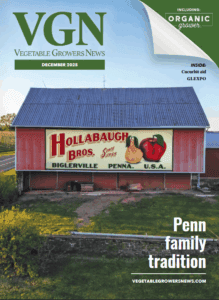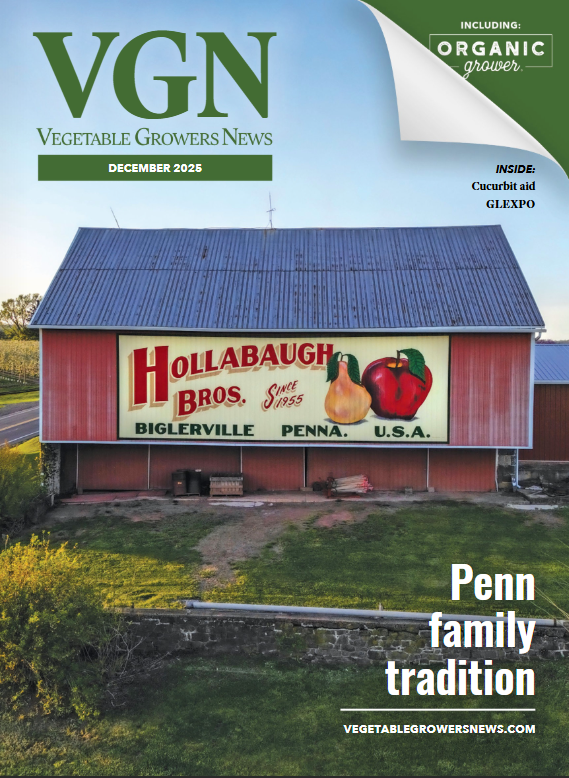Apr 7, 2007Penn State Taps Into School Pride With Blue and White Potato Chips
For years, William Lamont, vegetable crops professor at Penn State University (PSU), visualized a line of potato chips sporting the university’s colors. Utz Quality Foods in Hanover, Pa., has wanted to partner with Penn State to expand its grower base for gourmet potatoes. Fourth-generation Schuylkill County potato grower John Terwilliger has been interested in projects beneficial to the potato industry. Now, coordinating these interests in a research project, Lamont is seeing blue and white potato chips.
After considerable research and trials, the blue and white potato chip test marketing kicked off during Penn State’s football season. The 4-pound big box showcased at PSU’s Cellar Market enticed blue and white fans on their way to the home games.
Several Cellar Market patrons surmised that the blue chips were dyed. Quickly informed that they were natural, from Adirondack Blue potatoes, they became more enthusiastic. A few noted the purple shading, but it didn’t deter their enjoyment. The $17.50 price, which helps fund the International Association of Students in Agricultural and Related Sciences Club, did not impact the brisk sales.
Half the chips are made from Adirondack Blue. A white chipping potato such as Atlantic, Snowden, Pike, Marcy, Andover or Dakota Pearl makes up the other half of the mix.
Utz Quality Foods, a privately owned family company, has been in the snack foods business in Hanover, Pa., for 80 years. Spokesman Gary Laabs said Utz welcomed the opportunity to learn more about the blue potato’s growing and storage characteristics.
“A notable challenge with the blue potatoes that we face is maintaining a consistent blue color late in storage,” Laabs said.
Sugars can accumulate, then override the blue pigmentation and cause browning in the chips.
Utz processes blues separately. The lower specific gravity of blue potatoes requires a longer cooking time for chip production. The company has used All Blue, Russian Blue and Purple Majesty. Adirondack Blue gives Utz a deeper, more consistent blue chip without the pronounced white vascular ring of some blue varieties. Purple Majesty can produce deep blue chips, and generally is higher in gravity than other blue varieties.
As part of Cornell’s potato breeding program, Walter De Jong developed Adirondack Blue from N40-1 (Chieftain x Black Russian) x NY96. The seed potato supplier Tucker Farms in Gabriels, N.Y., reported Adirondack Blue to be resistant to golden nematode but susceptible to common scab and silver scurf, and it may be susceptible to seed-piece decay. It yields better than most blue varieties. Released in 2003, Adirondack Blue continues to be refined by the breeder.
Potato grower John Terwillinger packs potatoes on his family’s Huntsinger Farms near Hegins, Pa. The Huntsinger crew planted the Adirondack Blue whole seed pieces on April 28. Spacing was 9.6 inches on the 0.42 acre plot. Using a rate of 800 pounds per acre, 11-7-19 fertilizer was banded. Mocap at 22 pounds per acre, Quadris at 10 ounces per acre, and Admire Pro at 9 ounces per acre were applied at planting. The crop was sidedressed with 15-0-15 at the rate of 375 pounds per acre. Throughout the season, Terwillinger followed the standard recommended weed, insect and disease control program. When needed, overhead irrigation was implemented at the rate of 0.2 inches per hour. Unfortunately, over 10 inches of rain fell in just two and a half days in June.
When the potatoes had sized adequately for chip production, Terwillinger killed the vines. Schuylkill County Extension Agent George Perry advised that chip producers do not prefer large potatoes. The Aug. 11 harvest yielded about 262 cwt. per acre. Terwillinger estimated stand reduction of 10 percent due to seed piece decay. Potential yield, of course, was further curtailed with vine killing.
After harvest, Huntsinger Farms stores potatoes at 45º F. An innovative farmer, Terwillinger modeled his washing system from the British. After washing, the Adirondack Blue tubers sparkle with a brilliant purplish-blue hue. They are graded and inspected prior to shipment.
As it does for its Gourmet Medley package of dark russets, sweet potatoes, regular and blue potatoes, Utz uses expeller pressed sunflower oil. This unsaturated fat, plus the antioxidant properties of blue potatoes, imparts a healthier chip. Research Geneticist Charles R. Brown of USDA’s Agricultural Research Service said, regarding the anthocyanins in blue-fleshed potatoes, “They may be degraded a little during frying, but they are still mostly present and still serve as antioxidants.”
“It’s a great idea to try something new and different,” Lehigh County Extension Director Robert Leiby said. “We’re constantly working with the agricultural community and potatoes.”
Generating excitement creates a new marketing opportunity, he said. Lehigh County ranks high among potato producers in Pennsylvania.
“I believe the project has shown that there is a large potential market for blue and white chips, maybe packaged appropriately and licensed by Penn State to Utz or others,” Lamont said. “I can envision a nice tin of Nittany Lions Chips being sold via the Penn State Alumni Store Web site.”
A good supply of blue potatoes will be needed, and more quality growers such as Huntsingers will be required for market expansion, he said.
















